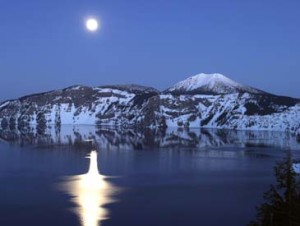Wilderness proposed at Crater Lake
Mail Tribune
Medford, Oregon
August 07, 2009
BY PAUL FATTIG
Several environmental groups are proposing a new wilderness area blanketing Crater Lake National Park and stretching some 75 miles from Crescent Lake south to Highway 140 at Fish Lake.
 The moon rises over the East Rim and Mount Scott (during winter) at Crater Lake National Park, photo by Robert Mutch |
The proposed Crater Lake Wilderness, covering some 450,000 acres, would ensure the “quiet beauty” of Crater Lake would be protected, and thwart an effort by a Bend firm to offer helicopter tours around the lake, said Erik Fernandez, wilderness coordinator for Portland-based Oregon Wild.
The proposed area, which would include the park and embrace the Sky Lakes Wilderness, Rogue-Umpqua Divide Wilderness and the Mount Thielsen Wilderness, would create more wilderness connectivity, Fernandez said when announcing the proposal Thursday.
“When we look at Oregon, we think of ourselves as a green state, but only 4 percent is protected as wilderness and only one national park,” Fernandez said. “We have a responsibility to future generations to do better.
“This would not include roads, the lodge or other developed areas — just the backcountry up there,” he added.
While last month’s news of a proposal by Leading Edge Aviation in Bend to offer helicopter tour flights over Crater Lake helped spark the wilderness proposal, other factors, including a planned logging operation in the Umpqua National Forest near the park boundary, heated up the effort, he said.
Travis Warthen, vice president of Leading Edge, said establishing the entire area as a wilderness would make it easier for the company to fly around Crater Lake.
“In a wilderness area, we can fly helicopters all day long,” he said. “We have a request to stay above 2,000 feet above wilderness areas, but that’s about it. With our proposal, once the facts come out, we’ll be a compatible use for the lake.
Fernandez countered that while flights over wilderness areas are generally restricted to 2,000 feet above the ground, Congress, which “officially” creates wilderness areas, could require flights to stay higher in any new wilderness legislation or simply ban them outright. Exceptions could be made for administrative or emergency flights, he added.
“Crater Lake, Mount Thielsen, Mount Bailey and the headwaters to Rogue and Umpqua Rivers surrounding the park are the crown jewels of the southern Cascades,” Fernandez said. “We owe it to our children and grandchildren to protect the wildlands around these areas forever as a haven for Oregonians who seek natural beauty, freedom and opportunities for quiet recreation.”
Joining Oregon Wild in the proposal is Umpqua Watersheds and the Crater Lake Institute, a group dedicated to protecting Crater Lake. The groups sent a letter to the National Park Service and the FAA on Thursday advising them that helicopter tours of the park could be illegal under several federal laws.
They had also requested that U.S. Sen. Ron Wyden, D-Oregon, introduce legislation to create the new wilderness. Wyden announced his opposition to helicopter tours over the park during a Senate hearing late last month to discuss the future of the park service with Jonathan Jarvis, a longtime park service employee who is the nominee to head the agency.
Neither Wyden nor a spokesman for the park could be reached to comment on the proposal late Thursday afternoon.
The aviation firm submitted an application to the Federal Aviation Administration in June for a permit to fly over the park. The application seeks approval for as many as 300 flights a year. Aircraft would have to remain at least 1,500 feet above the ground and none could operate inside the caldera, according to the firm.
An FAA representative told The Associated Press that it would take “several years” to consider the application because of the backlog of applications at other national parks. However, the firm has requested an interim permit.
With a depth of nearly 2,000 feet, Crater Lake is the nation’s deepest lake. It filled after the peak known as Mount Mazama exploded some 7,700 years ago, leaving a deep caldera.
For more information, visit the Web site at www.oregonwild.org and www.leadingedgeavn.com.
Other pages in this section

